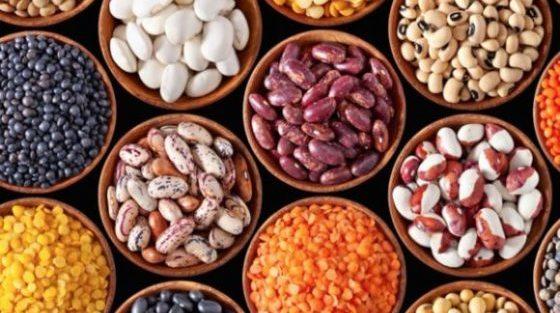
Legumes
Legumes, also called legumes, Fabaceae or Papilionaceae, are flowering plants of the Fabales order; the legumes produce a fruit called pod, of which the seeds enclosed within are mainly edible.
They are legumes: beans, peas, broad beans, chickpeas, lentils, soybeans, lupins, peanuts, cicerchie, caiani, carob etc.
Legumes are foods that boast extreme flexibility; they can be used as a first course, as a side dish, as a second course (if combined with cereals) and some of their flours can be used in the food additives sector (thickeners - such as carob seed flour E410) or as a cutting substrate ( e.g. chickpea flour) to reduce the amount of wheat in food products.
Nutritional Properties
Legumes represent a category of foods with numerous nutritional qualities; despite some recent theories have tried to discredit them, these seeds continue to demonstrate a very high therapeutic efficacy in most of the dysmetabolic pathologies of supercharging aetiology; in other words, teaching to use legumes as a substitute for refined cereals (in people who tend to overindulge) leads to a significant reduction in excess calories, an increase in dietary fiber (with moderation of the global glycemic index and absorption of fat), a reduction of cholesterol by lecithin) and circulating triglycerides, and an increase in the intake of vitamins and mineral salts.
Compared to refined cereals and related starchy derivatives, legumes provide:
- More protein
- Less carbohydrates
- Less calories
- More dietary fiber
- More potassium (K)
- More iron (Fe)
- More calcium (Ca)
- More phosphorus (P)
- More thiamine (B1)
- More riboflavin (B2)
- More niacin (PP)
Furthermore, they do not contain gluten.
Protein
Legume proteins are called medium biological value (average VB) and are made from a minimum of 18% (some chickpeas) to a maximum of 44,3% (dried lupins). The biological value is a qualitative evaluation parameter of food proteins which is based on the analysis of the essential amino acids contained in them; more precisely, the VB is given by the similarity in composition between the examined protein and the human one. It is expressed with a numerical value in turn referred to the protein nitrogen actually absorbed and used by the body, therefore net of urinary, fecal, skin, etc. losses. (see the article: "Protein quality"). The reference protein for calculating the biological value is that of the egg, which has a VB = 100 (it is estimated that on 100 g of amino acids 32,256 g of essential aa and 67,744 g of non-essential aa are identified).
Note: the biological value shown in the tables refers to raw foods; they, after firing, have a considerably reduced VB. It follows that: almost all dietary proteins (including legume proteins), compared to those of human tissues or raw eggs, are deficient in one or more essential amino acids. The level of specific deficiency can be evaluated as a percentage with a parameter known as index or chemical score (IC), that is: if the amino acid "X" is present in the human protein in quantity 10, while in the analyzed protein there are only 5 ... it is possible to define that the analyzed protein is deficient in the amino acid "X" for 50% (IPC = 50%).
Biological Value (VB)
- Eggs, milk and derivatives, meat and fishery products → contain HIGH VB proteins
- Legumes, nuts and cereal germs → contain AVERAGE VB proteins
- Refined flours of cereals, vegetables, mushrooms and fruit → contain LOW VB proteins
Calculating the biological value can be very useful, especially in "particular" diets such as veganism (potentially lacking in some essential amino acids), but also in evaluating the protein intake of the athlete; the latter, due to the fatigue induced by physical exercise, tends to require a greater protein intake and in particular of 3 branched amino acids (leucine, isoleucine and valine). Branched-chain amino acids are particularly subject to combustion as they do not require the liver's commitment (deamination and transamination) for the production of energy; therefore, food proteins in the diet of the athlete DON'T will may be deficient in branched aa.
Legume proteins are deficient above all in methionine and cysteine, while lysine (4 - 5,5%) and tryptophan (both deficient in cereals) are more than sufficient. By combining the proteins of legumes with those of cereals, it is therefore possible to achieve an overall biological BV equal to that of animal proteins.
Note: Another method to improve the VB of cereal proteins is to integrate them with a few similar animal-type molecules, which contain up to 7% of lysine. Comparing the biological value of some legumes and cereals:
| Beans or peas | 45 55 |
| Soy | 65 88 |
| Mixed cereals | ± 50 |
... with that of some foods of animal origin ....
| Latte | 70 80 |
| Beef | 69 81 |
| Fish | 63 90 |
it is obvious that the actual difference can easily be bridged through a dietary association between legume and cereal proteins.
Furthermore, observing the table below (percentage content of essential amino acids of some foods) it is also deducible that: combining cereals with legumes it is possible to easily reach a biological value almost similar to that of eggs.
| Nutrients (g) | Refined pasta | Dried beans | Whole egg | Whole milk |
| Acqua | 12.4 | 10.7 | 73.9 | 87.0 |
| Phenylalanine | 0.660 | 1.270 | 0.737 | 0.212 |
| Isoleucina | 0.410 | 1.306 | 1.000 | 0.248 |
| Leucine | 0.720 | 1.976 | 1.114 | 0.452 |
| Lysine | 0.228 | 1.708 | 0.900 | 0.300 |
| Methionine | 0.360 | 0.232 | 0.612 | 0.132 |
| Threonine | 0.324 | 0.997 | 0.612 | 0.184 |
| Tryptophan | 0.156 | 0.213 | 0.187 | 0.064 |
| Valine | 0.1468 | 1.395 | 0.912 | 0.264 |


























